
Fundamentals Of Wireless Communication
.pdf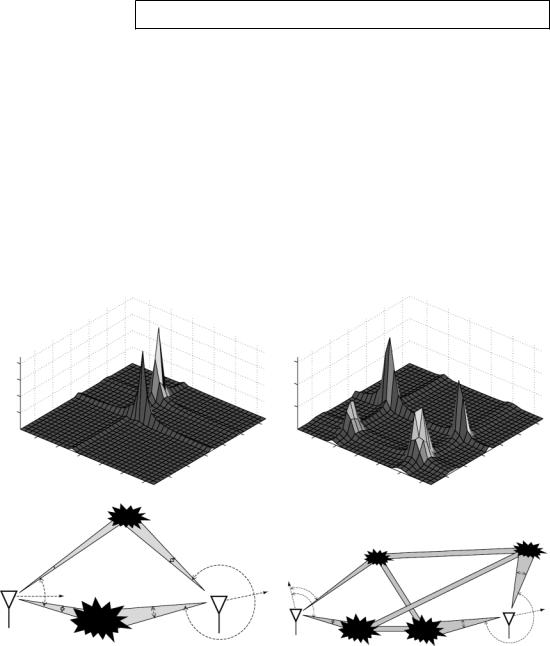

319 |
7.3 Modeling of MIMO fading channels |
of more paths, resulting in more non-zero entries of Ha and an increased number of degrees of freedom.
The number of degrees of freedom is explicitly calculated in terms of the multipath environment and the array lengths in a clustered response model in Example 7.1.
Example 7.1 Degrees of freedom in clustered response models
Clarke’s model
Let us start with Clarke’s model, which was considered in Example 2.2. In this model, the signal arrives at the receiver along a continuum set of paths, uniformly from all directions. With a receive antenna array of length Lr, the number of receive angular bins is 2Lr and all of these bins are non-empty. Hence all of the 2Lr rows of Ha are non-zero. If the scatterers and reflectors are closer to the receiver than to the transmitter (Figures 7.10(a) and 7.14(a)), then at the transmitter the angular spread %t (measured in terms of directional cosines) is less than the full span of 2. The number of non-empty rows in Ha is therefore Lt%t", such paths are resolved into bins of angular width 1/Lt. Hence, the number of degrees of freedom in the MIMO channel is
min Lt%t" 2Lr |
(7.75) |
If the scatterers and reflectors are located at all directions from the transmitter as well, then &t = 2 and the number of degrees of freedom in the MIMO channel is
min 2Lt 2Lr |
(7.76) |
the maximum possible given the antenna array lengths. Since the antenna separation is assumed to be half the carrier wavelength, this formula can also be expressed as
min nt nr
the rank of the channel matrix H
General clustered response model
In a more general model, scatterers and reflectors are not located at all directions from the transmitter or the receiver but are grouped into several clusters (Figure 7.16). Each cluster bounces off a continuum of paths. Table 7.1 summarizes several sets of indoor channel measurements that support such a clustered response model. In an indoor environment, clustering can be the result of reflections from walls and ceilings, scattering from furniture, diffraction from doorway openings and transmission through soft partitions. It is a reasonable model when the size of the channel objects is comparable to the distances from the transmitter and from the receiver.
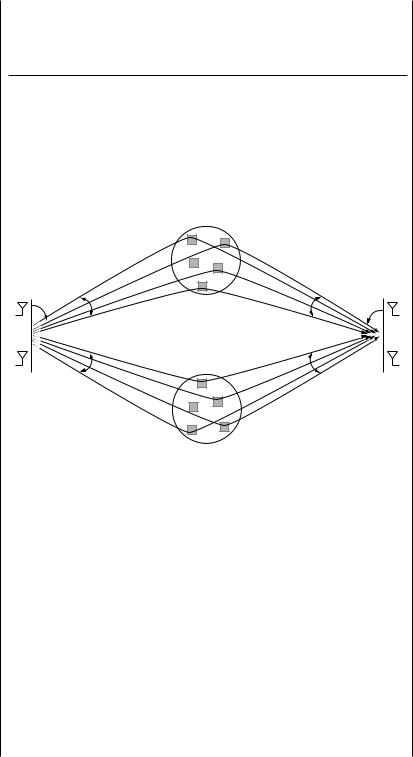
320 |
MIMO I: spatial multiplexing and channel modeling |
Table 7.1 Examples of some indoor channel measurements. The Intel measurements span a very wide bandwidth and the number of clusters and angular spread measured are frequency dependent. This set of data is further elaborated in Figure 7.18.
|
Frequency (GHz) |
No. of clusters |
Total angular spread (#) |
USC UWB [27] |
0–3 |
2–5 |
37 |
Intel UWB [91] |
2–8 |
1–4 |
11–17 |
Spencer [112] |
6.75–7.25 |
3–5 |
25.5 |
COST 259 [58] |
24 |
3–5 |
18.5 |
|
|
|
|
Cluster of scatterers
φ t |
Θ t,1 |
Θ r,1 |
φ r |
|
|||
|
Θ t,2 |
Θ r,2 |
|
Transmit |
|
|
Receive |
array |
|
|
array |
Figure 7.16 The clustered response model for the multipath environment. Each cluster bounces off a continuum of paths.
In such a model, the directional cosines &r along which paths arrive are partitioned into several disjoint intervals: &r = k&rk. Similarly, on the transmit side, &t = k&tk. The number of degrees of freedom in the channel is
|
|
Lr &tk" |
|
min k |
Lt &tk" k |
(7.77) |
For Lt and Lr large, the number of degrees of freedom is approximately
min Lt%t total Lr%r total |
|
(7.78) |
|
where |
|
|
|
%t total = k |
&tk and %r total = k |
&rk |
(7.79) |
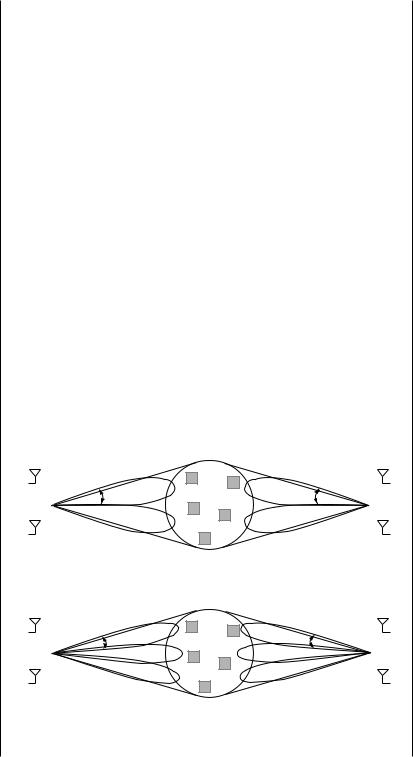
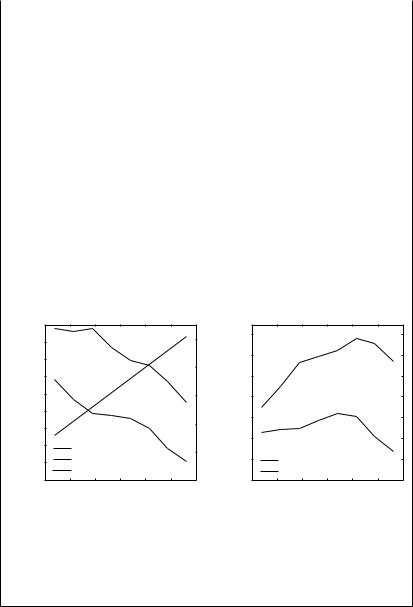
322 MIMO I: spatial multiplexing and channel modeling
typically decreases with the carrier frequency. The reasons are two-fold:
•signals at higher frequency attenuate more after passing through or bouncing off channel objects, thus reducing the number of effective clusters;
•at higher frequency the wavelength is small relative to the feature size of typical channel objects, so scattering appears to be more specular in nature and results in smaller angular spread.
These factors combine to reduce %t total and %r total as the carrier frequency increases. Thus the impact of carrier frequency on the overall degrees of
freedom is not necessarily monotonic. A set of indoor measurements is shown in Figure 7.18. The number of degrees of freedom increases and then decreases with the carrier frequency, and there is in fact an optimal frequency at which the number of degrees of freedom is maximized. This example shows the importance of taking into account both the physical environment as well as the antenna arrays in determining the available degrees of freedom in a MIMO channel.
|
0.45 |
|
|
|
|
|
|
|
|
7 |
|
|
|
|
|
|
|
0.4 |
|
|
|
|
|
25 |
|
|
|
|
|
|
|
|
|
|
|
|
|
|
|
|
|
|
|
|
|
|
|
|
||
|
|
|
|
|
|
|
|
|
|
|
|
|
|
|
|
|
|
0.35 |
|
|
|
|
|
|
|
|
6 |
|
|
|
|
|
|
|
|
|
|
|
|
20 |
|
) |
|
|
|
|
|
|
|
|
|
|
|
|
|
|
|
|
|
|
|
|
|
|
|
||
|
0.3 |
|
|
|
|
|
|
|
−1 |
5 |
|
|
|
|
|
|
|
|
|
|
|
|
|
1 |
(m |
|
|
|
|
|
|
||
total |
0.25 |
|
|
|
|
|
15 |
) |
/λ |
4 |
|
|
|
|
|
|
|
|
|
|
|
(m |
|
|
|
|
|
|
|||||
|
|
|
|
|
|
|
|
- |
c |
|
|
|
|
|
|
|
Ω |
0.2 |
|
|
|
|
|
1/λ |
total |
3 |
|
|
|
|
|
|
|
|
0.15 |
|
|
|
|
|
10 |
|
Ω |
|
|
|
|
|
|
|
|
|
|
|
|
|
|
|
|
|
|
|
|
|
|||
|
|
|
|
|
|
|
|
|
2 |
|
|
|
|
|
|
|
|
0.1 |
|
Ω total in office |
|
|
|
|
|
|
|
|
|
|
|
||
|
|
|
|
5 |
|
|
|
|
|
|
|
|
|
|||
|
|
|
|
|
|
|
|
|
|
|
|
|
|
|||
|
0.05 |
|
Ω total in townhouse |
|
|
|
|
1 |
|
Office |
|
|
|
|
||
|
0 2 |
|
1/λ c |
|
|
|
8 0 |
|
|
0 2 |
|
Townhouse |
|
|
|
|
|
3 |
4 |
5 |
6 |
7 |
|
|
3 |
4 |
5 |
6 |
7 |
8 |
|||
|
|
|
Frequency (GHz) |
|
|
|
|
|
|
Frequency (GHz) |
|
|
||||
|
|
|
|
(a) |
|
|
|
|
|
|
|
|
(b) |
|
|
|
Figure 7.18 (a) The total angular spread total of the scattering environment (assumed equal at the transmitter side and at the receiver side) decreases with the carrier frequency; the normalized
array length increases proportional to 1/c . (b) The number of degrees of freedom of the MIMO channel, proportional to total/c , first increases and then decreases with the carrier frequency. The data are taken from [91].
Diversity
In this chapter, we have focused on the phenomenon of spatial multiplexing and the key parameter is the number of degrees of freedom. In a slow fading environment, another important parameter is the amount of diversity in the channel. This is the number of independent channel gains that have to be in a deep fade for the entire channel to be in deep fade. In the angular domain MIMO model, the amount of diversity is simply the number of non-zero


324 |
MIMO I: spatial multiplexing and channel modeling |
|||||||||||||
Figure 7.20 An antenna array |
|
|
|
|
|
|
|
|
|
|
|
|
|
|
|
|
|
5 |
|
|
0 |
|
1 |
|
|
|
|
|
|
of length Lr partitions the |
|
|
|
|
|
|
|
|
|
|
|
|||
|
|
|
|
|
|
|
|
|
|
|
|
|||
receive directions into 2Lr |
|
4 |
|
|
|
|
|
|
|
|
2 |
|
|
|
angular windows. Here, Lr = 3 |
|
|
|
|
|
|
|
|
|
|
|
|
|
|
and there are six angular |
|
|
|
|
|
|
|
|
|
|
|
|
|
|
windows. Note that because of |
|
|
|
|
|
|
|
|
|
|
|
|
|
|
3 |
|
|
|
|
|
|
|
|
|
|
|
3 |
|
|
symmetry across the 0 − 180 |
|
|
|
|
|
|
|
|
|
|
|
|
||
axis, each angular window |
|
|
|
|
|
|
|
|
|
|
|
|
|
|
comes as a mirror image pair, |
|
|
|
|
|
|
|
|
|
|
|
|
|
|
and each pair is only counted |
|
|
|
|
|
|
|
|
|
|
|
|
|
|
as one angular window. |
|
4 |
|
|
|
|
|
|
|
|
2 |
|
|
|
|
|
|
|
5 |
|
|
0 |
|
1 |
|
|
|
|
|
|
|
|
|
|
|
|
|
|
|
|
|
|
|
|
Figure 7.21 Antennas are |
|
|
|
|
|
|
|
|
|
|
|
|
|
|
|
|
|
L r = 3, nr = 6 |
|||||||||||
critically spaced at half the |
|
|
|
|
|
|
|
|
|
|
|
|
|
|
|
|
|
|
|
|
0 |
|
|
|
|
|
|
|
|
wavelength. Each resolvable |
|
|
|
5 |
|
|
|
1 |
|
|
|
|
|
|
bin corresponds to exactly one |
|
4 |
|
|
|
|
|
|
|
|
|
2 |
|
|
angular window. Here, there |
|
|
|
|
|
|
|
|
|
|
|
|||
|
|
|
|
|
|
|
|
|
|
|
|
|
|
|
|
|
|
|
|
|
|
|
|
|
|
|
|
|
|
are six angular windows and |
|
|
|
|
|
|
|
|
|
|
|
|
|
|
six bins. |
|
|
|
|
|
|
|
|
|
|
|
|
|
|
|
|
|
|
|
|
|
|
|
|
|
|
|
|
|
|
3 |
|
|
|
|
|
|
|
|
|
|
3 |
|
|
|
|
|
|
|
|
|
|
|
|
|
|
|
|
|
4 |
|
|
|
|
2 |
|
5 |
|
0 |
1 |
|
|
|
|
|
|
|
0 |
1 |
2 |
3 |
4 |
5 |
 k
k
Bins
the sparsely spaced case ( r > 1/2), the beamforming patterns of some of the basis vectors have multiple main lobes. Thus, paths arriving in the different angular windows corresponding to these lobes are all lumped into one bin and cannot be resolved by the array (Figure 7.22). In the densely spaced case ( r < 1/2), the beamforming patterns of 2Lr of the basis vectors have a single main lobe; they can be used to resolve among the 2Lr angular windows. The beamforming patterns of the remaining nr − 2Lr basis vectors have no main lobe and do not correspond to any angular window. There is little received energy along these basis vectors and they do not participate significantly in the communication process. See Figure 7.23.
The key conclusion from the above analysis is that, given the antenna array lengths Lr and Lt, the maximum achievable angular resolution can be achieved by placing antenna elements half a wavelength apart. Placing antennas more sparsely reduces the resolution of the antenna array and can

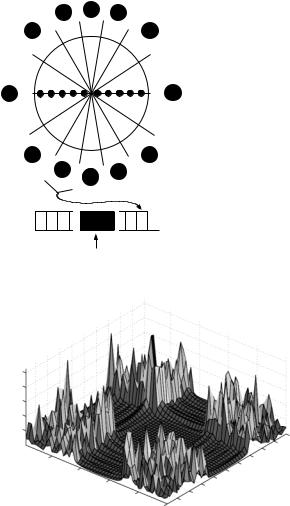
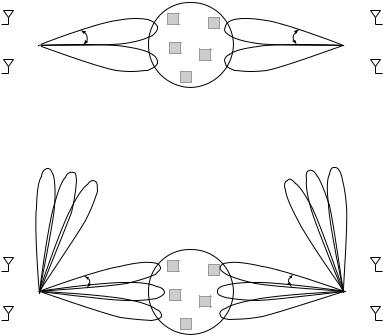

 k
k